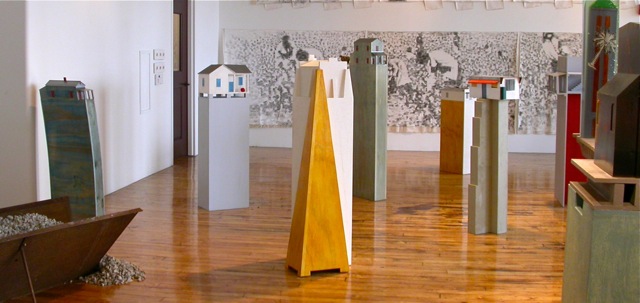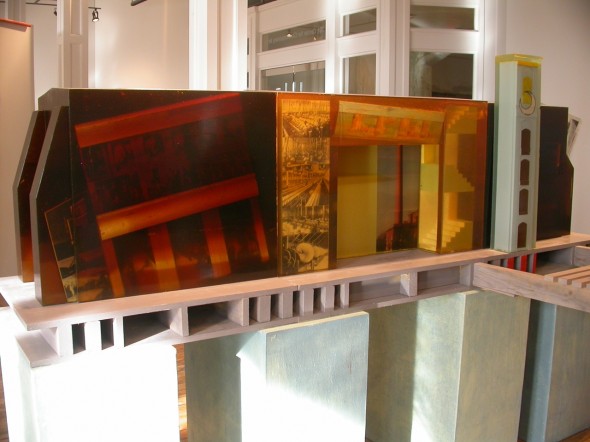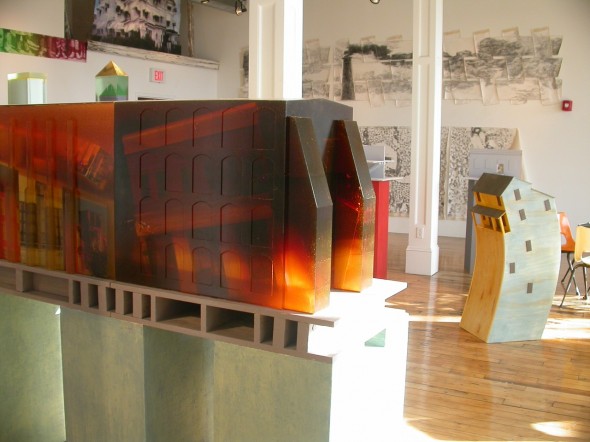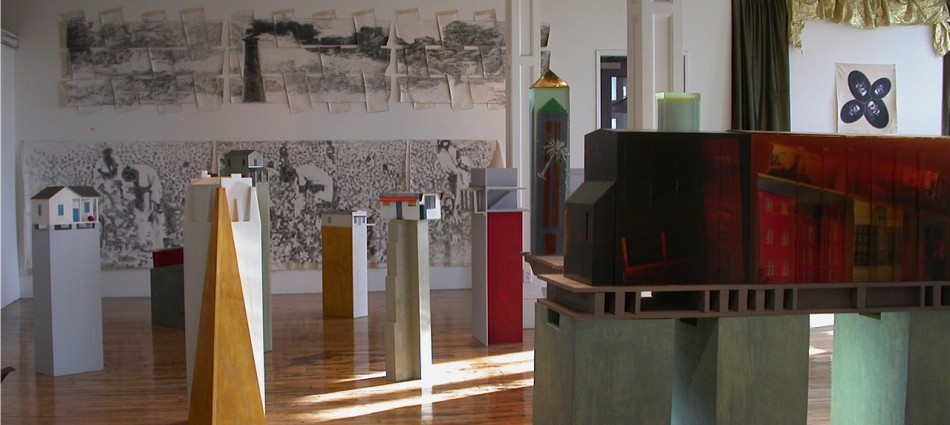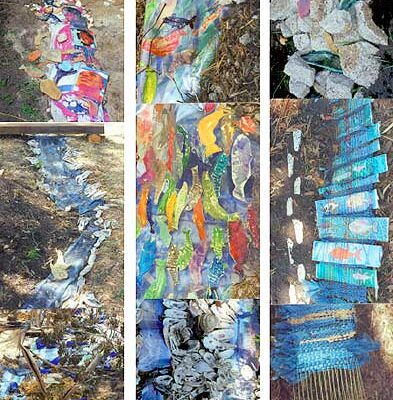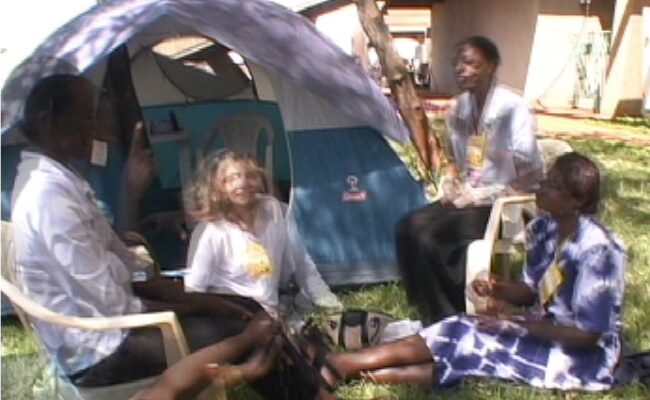In our “Introduction to 701CCA”, we were projecting how the installation of what, at the time, we had called “Impressions of Olympia” would develop. We had a three-month residency at 701 to produce a work having to do with the social and architectural history of the Olympia Cotton Mills and the operatives’ living quarters called Olympia Village. This was October 2009.
 |
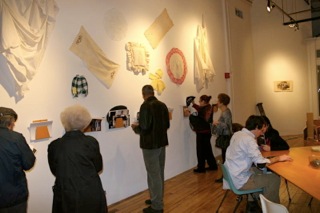 |
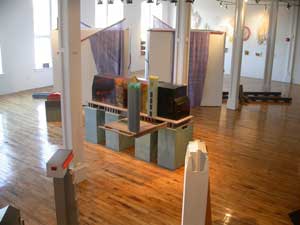 |
Today, February 2nd, 2010 we are taking a critical look at what developed from the original projections. Today, in the space of 701CCA, there is, in reality, a vast installation in six parts dedicated to the different facets we explored of “OLYMPIA” – the name finally given to the show – with the help of the amazingly present and dedicated 701CCA volunteers and board members. There are also three OPEN SPACES.
Although we can say that, from our very first visit, we had acquired a precise sense of how to use the space of the gallery and of the visual anchors, (we have a freehand sketch, presented to our sponsors the second day of the residency, which is still relevant today), it is through research and discoveries that, little by little, we consolidated the ever growing scope of the show. Every final decision, formal, spacial and conceptual was informed by facts on the ground. The product we ended up with is due, as much and possibly more, to what we learned than to what we knew.
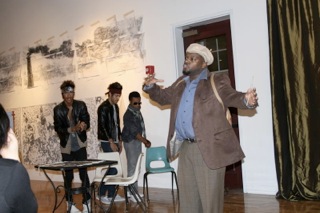
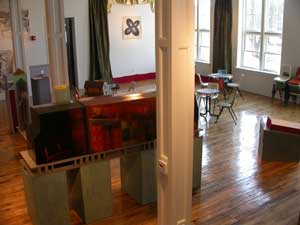
  |
There were less ‘Impressions of Olympia’ than fact-checking, translated into fact-shaping, artifacts, art moments.
Furthermore, our exploratory walks through the neighborhoods, our readings on and around the Mill Culture, Gwylène’s encounters with local personalities at their home or at a local bar, our own intentions to raise issues of labor, race relations, paternalism, religion …became the source of multiple new entries into and visions of Olympia. Besides, the necessity to plot a clear time line from the 1900’s till now, if we wanted, with some relevance, enlighten the subject matter with a touch of historical perspective, turned into a search for local historians, anthropologists, political and social figures. Finally, the subject “OLYMPIA” drowned our ‘Impressions of Olympia’ and we envisioned transforming the semi-mystical white cube-and-glass expanse of that magnificent gallery into a public forum, where the art pieces we were bringing would embody the vision, understanding and hopes of the community as much as our own. We were becoming hired hands, public artists without, mind you, the romanticism attached to such notions. How so? Because there is no embellishment, no gilding, no decorating in this show. The work is rather raw, simple in form and in intent. A visual response to the developing dialogue. It may belong in the art scene but, when, at the very end, it is left in the hands of the auctioneer it is more like in a gesture of “giving back” than of “making a killing”. Although 701 CCA or the artists do not live on thin air!
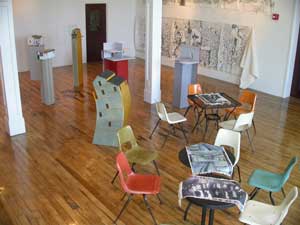 The most transformative aspect of the efforts described above has to do with 701CCA’s intent to reclaim its historic place in the Olympia neighborhood. 701 Whaley street, in Columbia, was the cultural center for the operatives of the mills, sometimes referred to as the YMCA. Yet, between then and now the sociocultural changes have been mind boggling. From “company store” to rental property, it takes a bit of deconstructing! And that is where the show, “OLYMPIA”, has been most energizing. It is the mix of visual works – in a gallery space ripped open to the public – with multiple activities – and weekly meetings and/or entertainment – animated by a fully dedicated team of volunteers and board members – plus a critical sense of history – which have made the experience successful. As for us, the artists, the lesson is: visual arts are a catalyst for change when its actors do not see themselves as outsiders looking in. Perception of place and role.
The most transformative aspect of the efforts described above has to do with 701CCA’s intent to reclaim its historic place in the Olympia neighborhood. 701 Whaley street, in Columbia, was the cultural center for the operatives of the mills, sometimes referred to as the YMCA. Yet, between then and now the sociocultural changes have been mind boggling. From “company store” to rental property, it takes a bit of deconstructing! And that is where the show, “OLYMPIA”, has been most energizing. It is the mix of visual works – in a gallery space ripped open to the public – with multiple activities – and weekly meetings and/or entertainment – animated by a fully dedicated team of volunteers and board members – plus a critical sense of history – which have made the experience successful. As for us, the artists, the lesson is: visual arts are a catalyst for change when its actors do not see themselves as outsiders looking in. Perception of place and role.
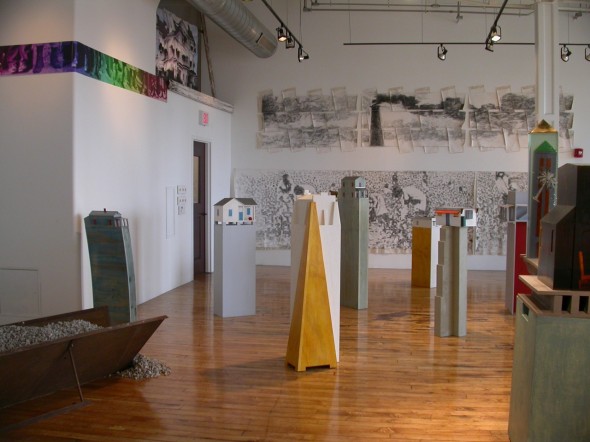 Now we can walk through “OLYMPIA” and double-check with the images attached to this text.
Now we can walk through “OLYMPIA” and double-check with the images attached to this text.
Earlier, we said: an installation in six parts and three open spaces, all in one gallery and with one ambitious intent: that of offering to the OLYMPIA community an image it could call its own.
 |
 |
 |
The open spaces are public spaces, reminding us of what 701 Whaley street used to be. Among other things, at the Center, there was a theater: we offer a THEATER, a stage, a café-like space with tables and chairs. On the tables, canvas transfers of images from the original theater and audiences, memory as continuity. Extra chairs are stacked along a wall just in case. It is here that most of the public activities, every Wednesday evening, take place for the duration of the show. Then, there is a LIBRARY; table, chairs, shelves full of books and documents about and around the show. Books can be exchanged, (at the end they will go). The perfect place for small group meetings, book clubs, reading, writing … The third open space is vertical: WALL SPACE where, for example, a local teacher exhibits artifacts relating to mill and village. Where a gentleman said he would present an original cotton spool from the mill; it belongs to his mother who worked there for 33 years. Where the local Boys and Girls Club displays children drawings of the mill at night, as they see it. Where, also, the director of the quarry hangs some historic pictures of it.
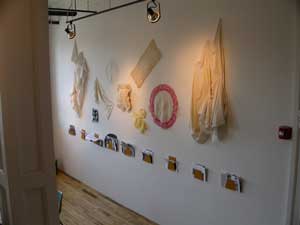 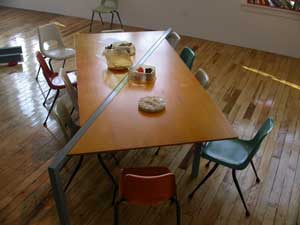 |
The installation in six parts grew from different aspects or elements that make up OLYMPIA. Four of them anchor the show visually: the railroad track, the gravel pit, the mill, the village. The others feed content and inferences into the show.
The RAILROAD TRACK is as present in the gallery space as it is around Olympia: cumbersome and noisy.
 |
 |
 |
The GRAVEL PIT is a rusty steel trough filled with stones, straight from the quarry, imbedded with four DVDs of more trains, bells and whistles included.
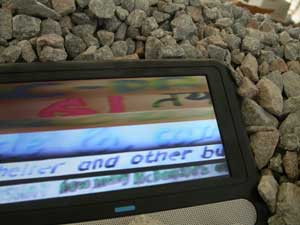  |
The MILL is actually The Mills: Olympia Mills and Granby Mills, combined into an 800 pound polyurethane rubber cast with inlays of objects, images, architectures, all representing aspects of the mills, from their industrial past to luxury condominiums. This aggressive gentrification process is further emphasized by the swimming pool, at the back of the building, adorned with a Disney-like rendition of the mills’ bell towers.
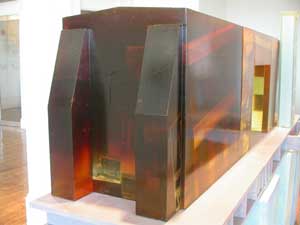 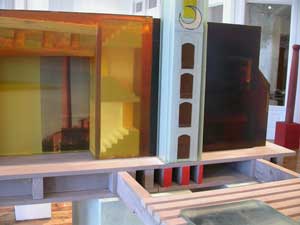 |
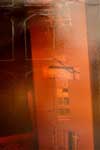 |
 |
 |
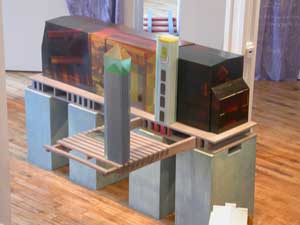 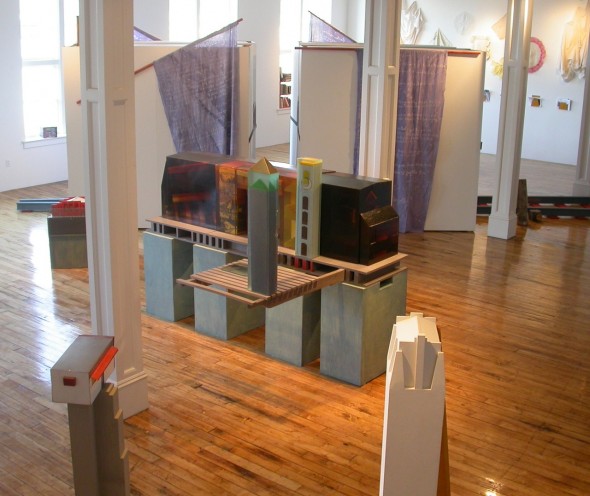 |
The VILLAGE is an ensemble of twelve scaled down buildings, landmarks of Olympia Village, from the Union Hall to a two-story shot gun house. From five prominent churches in the neighborhood to a run down trailer. Let’s not omit the school and its architectural twin, the armory. Each building perched on a stand which is more like an extension of it, a root. The challenge, here was to stay away from any reference to maquette, doll house, bird house and the likes! One of the pieces represents an architectural detail from the power house of the mills. Commentary on the strong aesthetic quality of Olympia’s industrial architecture.
 |
 |
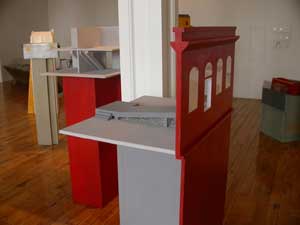 |
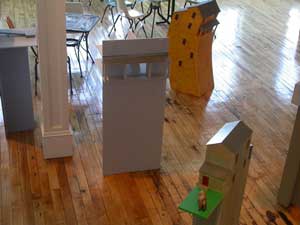 |
 |
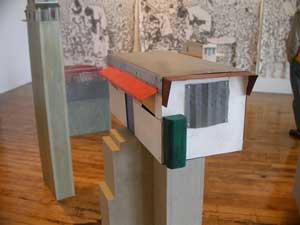 |
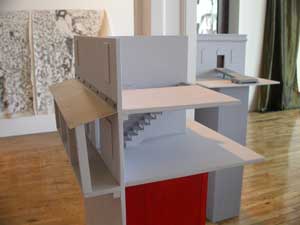 |
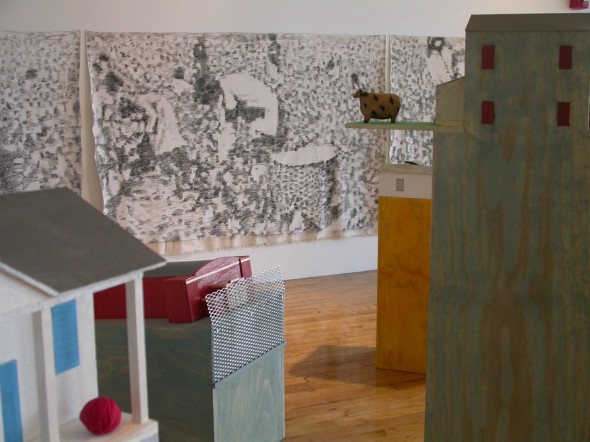 |
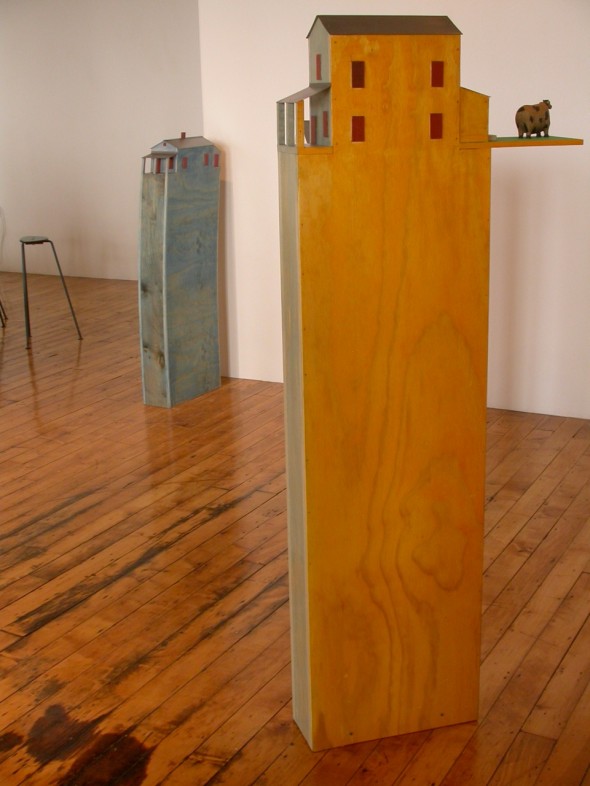 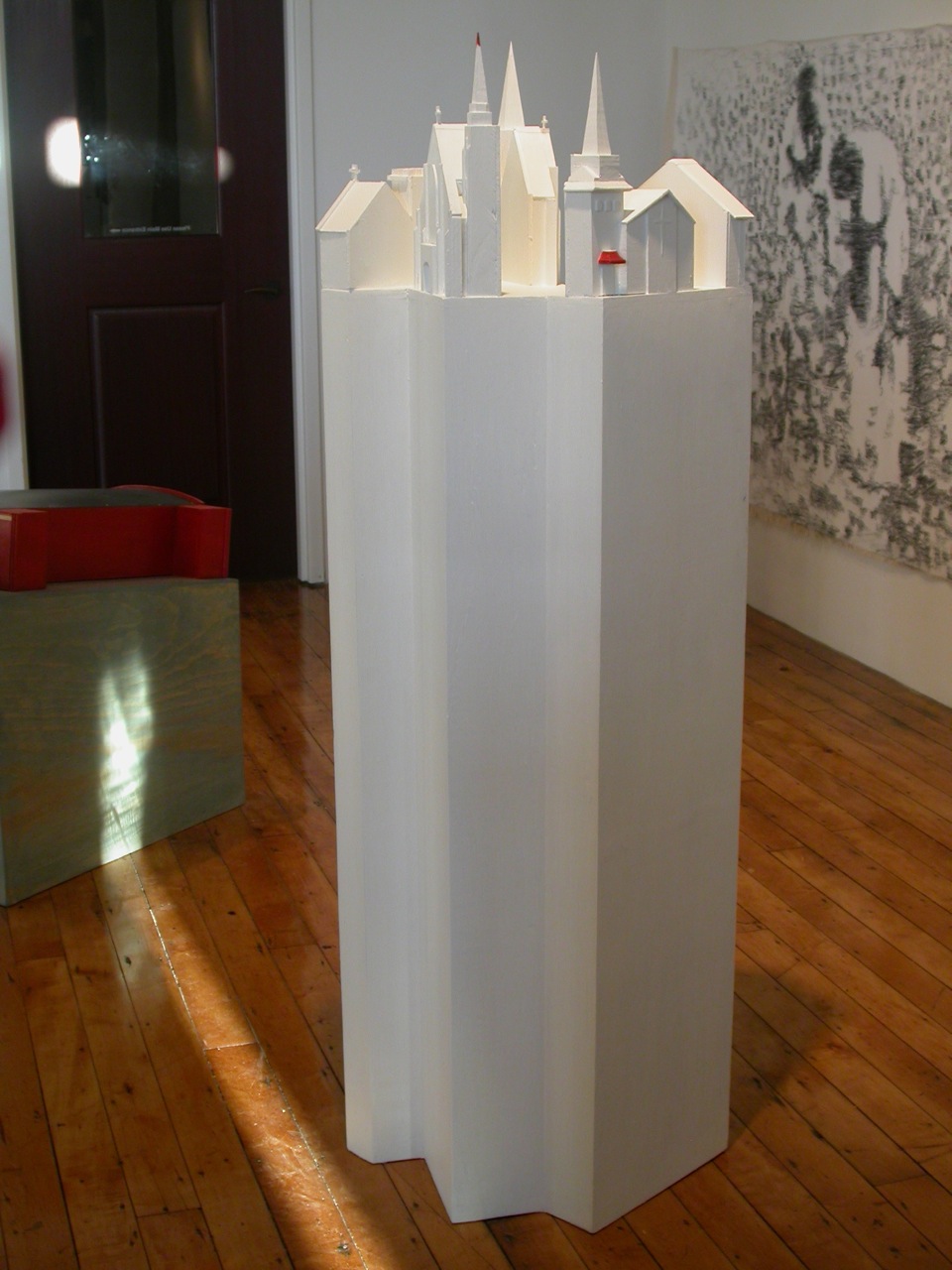  |
The HOUSE of W.B. Smith Whaley, founder and original owner of Olympia Mills. One mile away, on a hill, this photo-collage, this puzzle of a thousand windows and few walls, emulates the ten thousand windows of the mills. It is all here: distance, elevation, ambition!
And right below, a multicolored, horizontally stretched fresco of some twenty pairs of skinny legs, feet and shoes, standing deep in mud. Those of child laborers. Art and innuendo!
  |
 |
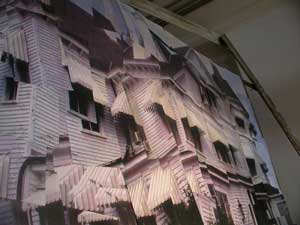 |
 |
A set of two large charcoal drawings, on woven bands of white canvas. Top drawing, a chimney stack proudly puffing out its black smoke. Bottom drawing, a white cotton field with black workers picking cotton to feed the mills. Treated in the impressionist/pointillist style, the further you are from the drawings the clearer you can read them. Distancing. And remembering that, although black workers were not, until World War Two, permitted to work in the mills, they could well do for picking, bailing and unbailing the goods.
 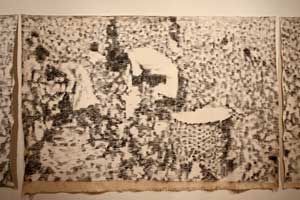 |
The indigo, batik banners: with handwritten texts by two local personalities. One about what the statue of “The Dough Boy” represents for the neighborhood, at a time when some would like to see it go. The other, a letter to the parishioners of St Luke about the future of OlLYMPIA, at a critical time when one of the anchors of the neighborhood is moving away: the Farmers Market. All stories collected and hand processed as testimonials to local vs. global.
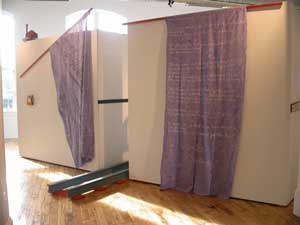 |
 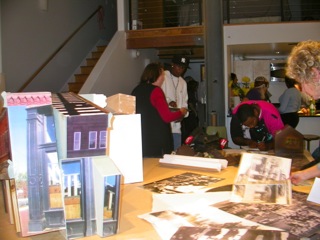 |
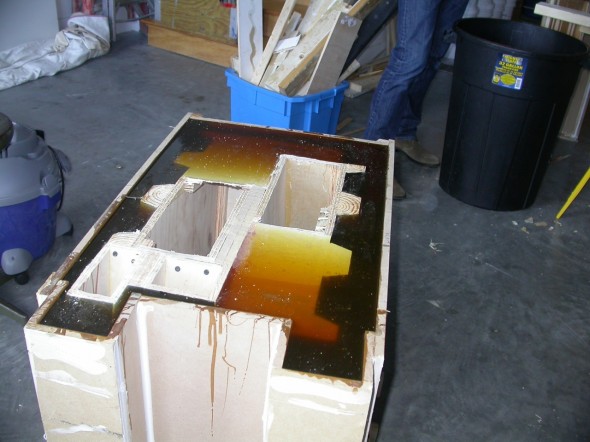 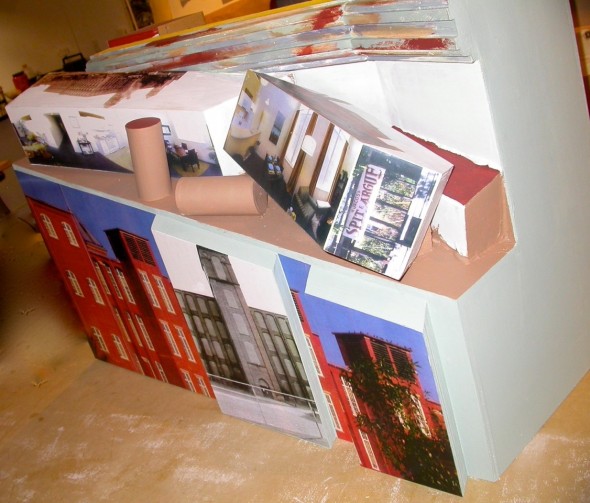 |
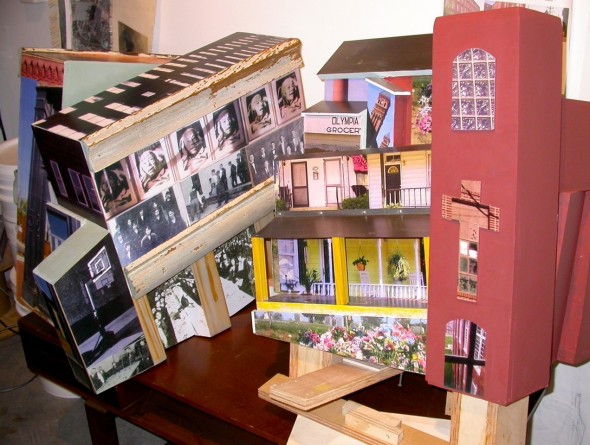 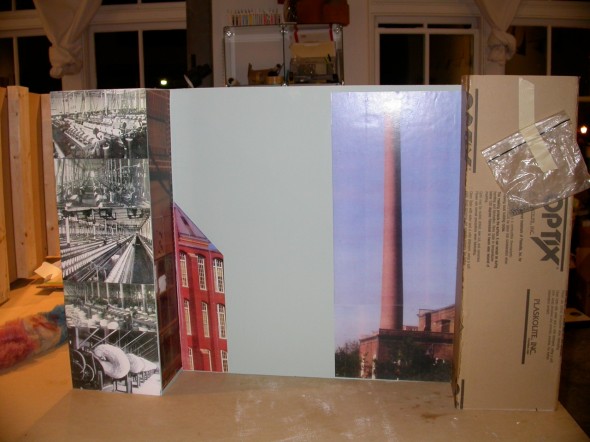 |
 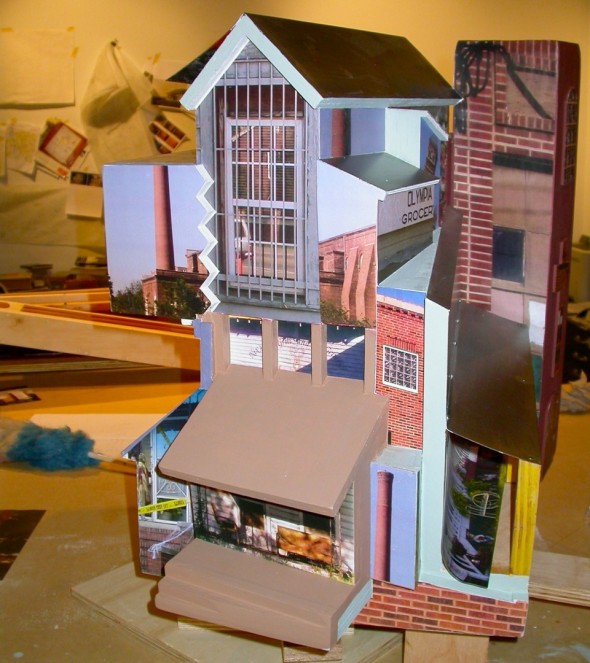 |
The junk pile, made of leftover wood from the molds and structures used to cast the mills. Some minor scraps actually fell on the railroad track … during transport … to … from … where?
Olympia: An Art Installation on Varying Concepts of Labor
by Gwylene Gallimard and Jean-Marie Mauclet
Frank Martin
Is art the presentation of particular objects or experiences fabricated by artists, or possibly our ideas pertaining to such objects or experiences? Or is art a synthetic and syncretic activity: a series of relationships between events, ideas, and objects that stand in some particular contextual, expressive interaction? The 701 Center for Contemporary Art, located in Columbia, South Carolina, at 701 Whaley Street, offered an innovative exhibition created by Charleston artists Gwylene Gallimard and Jean-Marie Mauclet entitled OLYMPIA: An Installation, open from January 7th, 2010 through February 21, 2010, which succinctly addressed these intriguing questions. The exhibition centered on themes of aesthetics in a comprehensive sense of the use of that term, incorporating ideas of community, critiques of individual points of view contrasted with communal sensibilities, and the employment of art as a method for interpreting the cultural significance of labor through its relation to social awareness. The aesthetic context and content of this unusual, communal art work moved beyond the simple engagement of the public with visual objects made by artists for display in an exhibition space, and extended into the surrounding community in an effort to actively include and interact with diverse constituent audiences in discussions concerning the complex social and cultural implications suggested by the exhibition’s conceptual richness.
The work’s six distinctive physical components corresponded to and symbolized actual sites and structures within the Olympia neighborhood, alluding to its extension into the larger environment and strategic locus within the overall urban plan of the city of Columbia. An implicit seventh component was the variability of interactions presented by members of the audience, which becomes a movable feature of the overall installation.
The first major feature was a long, low Gravel Pit, composed of a steel trough filled with the rubble of broken stones (gravel) taken from a local granite quarry. The second major area was the symbolic representation of the Olympia Mill Village. The third symbolic representational feature was a composite of both The Olympia and Granby Mills. Positioned at the heart of the installation, this element alluded to the past importance of the cotton mills in local life. The composite representation alluded to the presence of both edifices using a cast impression, fashioned in polyurethane (polymer resin), whose molds formed the last component of the exhibition as the detritus which is inevitable as the culmination of any construction project (or perhaps extending referentially to any creative activity). Component four was a symbolic representation of A Public Square, a metaphor for community dialogue, a meeting or gathering place, both within the exhibition itself, designed to facilitate conversations concerning its content, and an allusion to the sense of community engendered among the residents of the village proper.
The fifth installation feature was the sculpture of the Railroad Tracks, which both introduced and concluded the fabricated art components of the work. The railroad was an important symbolic component of the overall installation pertaining to the mill community, but it also served, because of its formal characteristics, as a reference to the representational, Western artistic tradition, alluding to perspectival, mimetic art images.
The sixth, and final physical component of the installation was its Library, an allusion to the didactic and documentary impetus of the exhibition’s rationale, as well as an instrumental means for providing research materials pertaining to the exhibition’s ideas to enhance the public’s understanding of the exhibition’s complex, expressive content features.
The concept of the installation and its aesthetic presentation were prefigured in one of Gallimard and Mauclet’s earlier works entitled The Future is On the Table, which was first installed at the I. P. Stanback Museum, at South Carolina State University. The dispersed, multi-component, complex approach employed by the artists can be characterized as process-intensive, participatory performance sculpture. In both works, the participation of the audience was crucial to realizing the full content of the installation and its contextual significations.
Both exhibitions offered their tours-de-force engagement with the public employing varying levels of aesthetic awareness, using diverse textures, surface contrasts, varied shapes and forms, and objects of interest. Each installation was a delight not only to the mind (due to their complex conceptual implications), but also to the eyes and senses of the viewer.
There are, of course, difficult realities that may be assessed from the political content and context of the Olympia installation. The mills have closed, the children of their worker populations, in many instances, educated beyond the point of being interested in retaining skilled-labor jobs at low wages, may themselves be a means through which the mill’s obsolescence was accomplished. The information in the installation’s Library helps us determine that the disintegration of our manufacturing culture actually has resulted in some significant benefits. Olympia was an exhibition centered on issues of labor, not only the labor of the mill workers, but also our shared labor toward a social vision as a culture, the intensive planning, processes, and labor required for structuring a complex expressive art exhibition, and the internal, continuous intellectual labor of conceptual understanding. Stated more simply, this exhibition was, clearly, a lot of work (on many different levels!). Gallimard and Mauclet intend to challenge us as an audience. Are we prepared as a society to address the tasks at hand as framed in their complex representations? They appear to feel confident that, indeed, we are and that, in fact, we can.
—————————————————–
1- The Future is On the Table was also a complex, multi-format installation work, which, intentionally extended itself into the local, regional, national and international (even inter-continental) communities, and which required audience participation and commitment. Its initial installation was at South Carolina State University in 2001 and continued through varying iterations into 2008. A catalogue (bearing the exhibition’s title), published by the Office of Cultural Affairs of the City of Charleston in conjunction with the City Gallery at Waterfront Park in Charleston, contains essays and lists the components of and the major participants in this complex, multi-continent art event. In my essay for the catalogue, entitled, “L’Avenir est sur la table,” pp. 33-40, I discuss the project’s complexity, and as a part of the democratized aesthetic thrust of the project, the essay is critiqued by random readers who challenge the assumptions of academic rationalized intellectual approaches to deconstructing the meanings of art experiences; a fascinating, revealing, humbling and intriguing experience for traditional critical inquiry.
